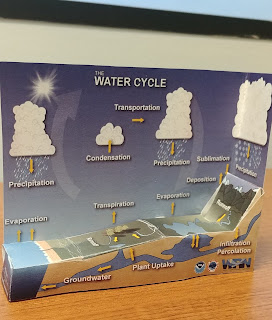See below for a special announcement!
***
A week ago, Frannie was in Cincinnati meeting with science educators and curriculum developers for the National Science Teaching Association regional conference. While she was there she met Dennis, a climate scientist from National Oceanic and Atmospheric Administration (NOAA), who was handing out a water cycle modeling activity called "What-A-Cycle"!Frannie thought the idea was so clever but she knew she wouldn't have the time do it because she had to get ready for Groundwater Week. She reached out to her friends at the Groundwater Foundation, knowing we'd be excited to share this craft with you today.
WHAT-A-CYCLE Water Cycle Paper Craft
You'll need:
- Scissors
- Glue or Tape
- What-a-cycle paper craft worksheet
- Colored Pencils/crayons/markers (optional)
STEPS:
 1. If you printed out a Black and White copy or an unlabeled copy of the What-a-cycle paper craft worksheet, you should first color it and label all the parts of the water cycle.
1. If you printed out a Black and White copy or an unlabeled copy of the What-a-cycle paper craft worksheet, you should first color it and label all the parts of the water cycle.
2. Cut out the atmospheric portion of the water cycle and then cut out the ground portion of the water cycle. You should now have 2 separate pieces.
 3. Fold the lettered tabs and along the marked lines on the ground piece and start to form a 3-D version of the groundwater and runoff portions of the water cycle. Once you start to see how the flat version transforms into 3-D, glue or tape the tabs together to form the model.
3. Fold the lettered tabs and along the marked lines on the ground piece and start to form a 3-D version of the groundwater and runoff portions of the water cycle. Once you start to see how the flat version transforms into 3-D, glue or tape the tabs together to form the model.
4. Fold along the dotted line in the atmospheric portion of the water cycle so that the largest precipitation cloud is at a right angle to the rest of the background.
5. Glue or tape the 3-D groundwater portion of the model to the atmospheric section of the model to complete the activity.
Frannie has been blogging about the water cycle a lot these past couple months.Go back to review her water cycle blogs first, and then trace as many paths a water droplet can take as you can find. What parts of the water cycle deep dives are shown in this model? What parts are missing?
Special Announcement!!
Catch Frannie next week on Facebook in a very special addition of "Water-Wise Wednesdays" as she completes the Groundwater Foundation Scavenger Hunt in the Groundwater Week Exhibit Hall! Frannie is excited to introduce you to several companies who make it possible for her (and her friends at the Groundwater Foundation!) to share the importance of groundwater through education.











